Infection rates are three times lower among fully-vaccinated Britons, a major study has found.
Data from the REACT study — which randomly tested 100,000 people between June 24 and July 12 — found 0.4 per cent of double-jabbed adults tested positive.
But prevalence of the virus was 1.21 per cent among those who had not yet received either jab.
The findings mirror tests results from a month earlier, highlighting how the vaccines have really helped in slashing infections.
But the same study, which ministers rely on to track the outbreak, found two doses were less effective at preventing infection than previously thought.
Imperial College London academics warned it is ‘highly likely’ the country will face another wave in the autumn.
The Government-backed team suggested children should be vaccinated to prevent another resurgence of the virus.
It came after Nicola Sturgeon yesterday revealed all over-16s in the UK are set to be given approval for Covid vaccines within the next few days.
Any move to green light jabs for children would mark a huge U-turn by health chiefs, who have until now recommended against routinely inoculating youngsters.
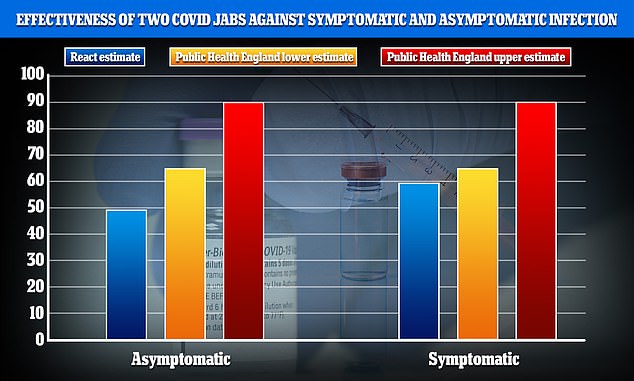
Data from the study also revealed that two doses of a vaccine are 49 per cent effective at preventing asymptomatic infection, a marked decline compared to other estimates. But the protection offered by the vaccines rises to 59 per cent against symptomatic cases, researchers said
Cases are continuing to fall in the UK, with just 21,691 positive Covid tests recorded yesterday — with the figure being the lowest for five weeks.
The Imperial study, funded by the Department of Health, warned the recent decline in cases could reverse when schools reopen in September.
It concluded vaccinating more children could ‘substantially reduce transmission’ and have ‘knock on benefits across the whole population’.
Researchers wrote: ‘In our data, the highest prevalence of infection was among 12 to 24 year olds.’
They claimed it raises the prospect ‘vaccinating more of this group by extending the UK programme to those aged 12-17 could substantially reduce transmission potential in the autumn when levels of social mixing increase’.
Half of all infections were in those aged five to 24 despite them only making up one in four of the population, reflecting lower vaccination rates in this age group.
Professor Paul Elliott, who led the study, said there was ‘the opportunity to get more vaccine into people’ over the summer.
Unveiling the findings in a briefing for health and science journalists, he said: ‘Clearly the issue of vaccinating teenagers is very important and topical.
‘It’s under constant review by the Joint Committee on Vaccination and Immunisation (JCVI).’
He added: ‘That age group is a potential source of infections, we’ve seen it in current data.’
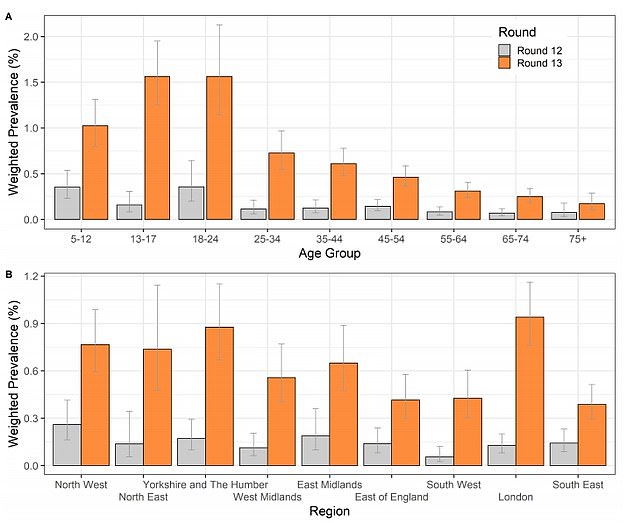
Top graph: Data from June 24 to July 12 (orange bars), gathered by Imperial researchers as part of the REACT study, shows that infection rates were highest in five to 24-year-olds. Half of all Covid infections were in this group, despite them making up just 25 per cent of the population. Nine times more children aged 13 to 17 tested positive in the most recent testing window compared to rates from May 20 to June 7 (grey bars). Bottom graph: Figures also show that infection rates were highest in London, where 0.94 per cent tested positive by July 12, up from just 0.13 per cent in the previous study period
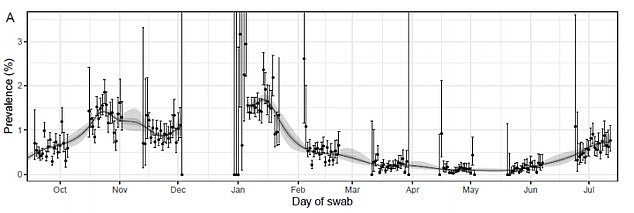
Positive PCR test samples taken as part of the REACT study closely follow the waves of the pandemic
Vaccinating children could reduce transmission in the autumn, experts say
Vaccinating over-12s could be a way to tackle a possible spike in cases when children return to school in September, Imperial College London experts said.
Between June 24 and July 12, five to 24-year-olds accounted for more than half of all infections, despite only representing a quarter of the population.
And nine times more children aged 13 to 17 tested positive compared to rates from May 20 to June 7.
Experts said their findings, part of the latest REACT study by Imperial, raises the prospect of expanding the vaccination rollout to over-12s, as this could ‘substantially reduce transmission’ in the autumn.
There is a risk infection levels rise later this year, when schools return, more people socialise more indoors and the continued presence of the Delta strain, despite high vaccination levels, they said.
Their study also found infection rates were highest in London, where 0.94 per cent tested positive by July 12, up from just 0.13 per cent in the previous study period.
Black people were also twice as likely to test positive for the virus (1.21 per cent), compared to white people (0.59 per cent).
And households with six people or more were three times more at risk (1.35 per cent) of catching Covid compared to single or two-person households (0.44 per cent).
Meanwhile, people in deprived areas were nearly twice as likely to test positive compared to the least deprived areas.
Advertisement
Imperial’s study found one in 160 people tested positive — a fourfold increase on the previous month.
Cases were driven up by the Delta variant replacing Alpha, with the more infectious strain making up 99.996 per cent of all cases in the country by mid-July.
Co-author Professor Steven Riley pointed to official data showing cases had started to level off in mid-July.
He added: ‘The very high growth that was happening up until the end of the Euros and the end of the academic year is not continuing.
‘Continued high vaccination uptake in younger ages through summer will reduce potential for transmission.’
Asked about the possibility of a fourth wave starting in September, Professor Riley said: ‘There are a number of key processes currently in our favour: schools, weather, outdoor mixing.
‘They will not be in our favour from September so there is a possibility prevalence may increase.’
He said that in the autumn there will be a ‘trade off’ between increased mixing and increased immunity from vaccination and infections.
Researchers studied Covid tests from 98,233 people taken in the most recent test window, of which 55,765 were double jabbed.
After adjusting for factors including age and sex, scientists estimated two doses of the vaccine roughly halves the risk of getting infected.
The figures are less optimistic than the estimates from Public Health England, which calculated they offer 65 to 90 per cent protection against infection.
Experts explained the discrepancy was due to how data is gathered — PHE based its calculations on Covid test results from people with symptoms
For comparison, the Imperial study tests a huge sample of the population, meaning it includes more asymptomatic cases.
Professor Elliott said vaccines were even more effective at preventing hospitalisation and death.
He insisted the findings show the jabs are still ‘highly effective’ but admitted it would be a ‘good thing’ if they could be tweaked to become better.
Researchers said their findings — which did not breakdown efficacy rates between Pfizer and AstraZeneca — are also in line with data from Israel.
Data also showed one in 25 double jabbed people picked up the virus after being in close contact with someone who was infected.
For comparison, unvaccinated people have double the risk of catching the virus.
Findings also suggest fully immunised people experience a less severe infection and are less likely to transmit the virus to other people.
It took more rounds of PCR tests – 27 cycles versus 23 – to pick up the virus in vaccinated compared to unvaccinated people, suggesting those who got the jabs experienced a lower viral load.
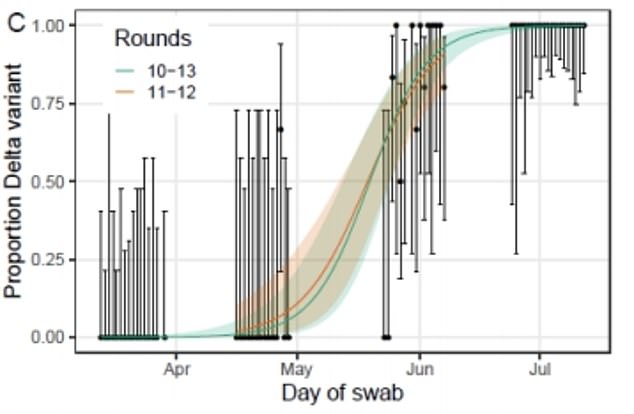
The graph shows the proportion of positive Covid swabs taken as part of the REACT trial that sequencing identified as the Delta variant
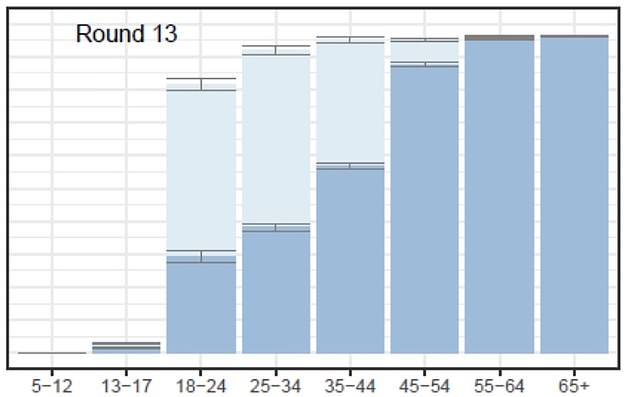
The graph shows the proportion of people in each age group who had received one Covid jab (light blue) and who were fully immunised (dark blue)
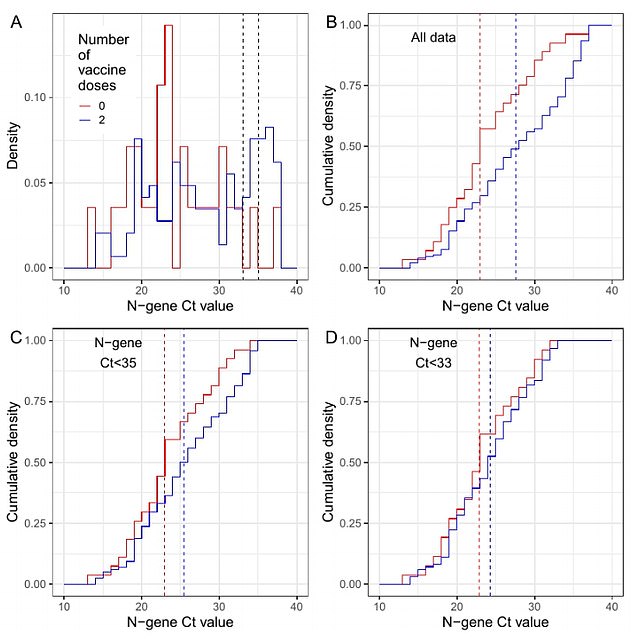
The graph shows the Ct value in infected people aged 18 to 64 who had not been vaccinated (red line) compared to double jabbed Brits (blue line). Each graph shows that those not protected against Covid had lower Ct levels, which are associated with higher amounts of the virus in their test sample and is usually linked with a more severe infection
Health Secretary Sajid Javid said: ‘Our vaccination rollout is building a wall of defence that means we can carefully ease restrictions and get back to the things we love, but we need to be cautious as we learn to live with this virus.
‘Today’s report shows the importance of taking personal responsibility by self-isolating if you are contact traced, getting tested if you have symptoms and wearing face coverings where appropriate.
‘I urge anyone who has yet to receive a vaccine to get jabbed and take up both doses – the vaccines are safe and they are working.’
Dr Tom Wingfield, a senior clinical lecturer and honorary consultant physician at the Liverpool School of Tropical Medicine, said the findings show vaccines are ‘contributing to a decrease’ in Covid transmission and symptomatic illness.
He said: ‘The REACT-1 findings, when coupled with other studies demonstrating the impact of coronavirus vaccines on reducing hospitalisation and death from Covid, are encouraging.’
But the study ‘serves as a reminder’ that ‘even with extremely high vaccine coverage, we are highly likely to have a further wave of SARS-CoV-infections in the autumn’, Dr Wingfield said.
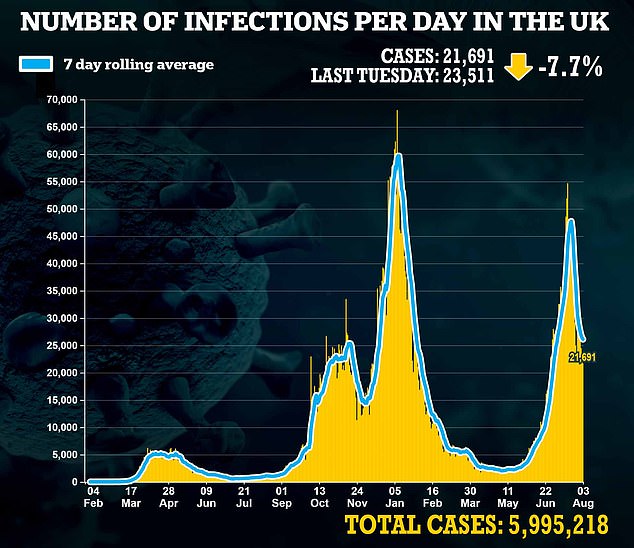
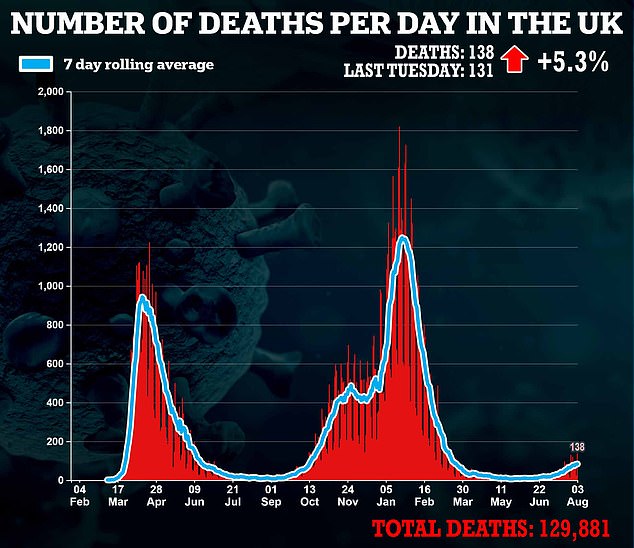
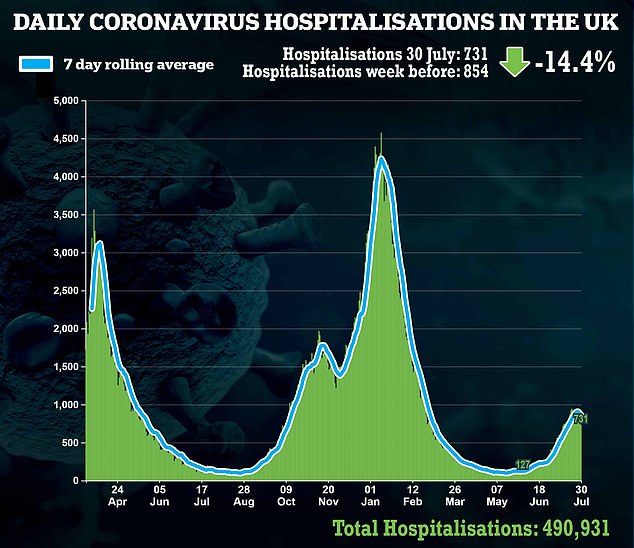
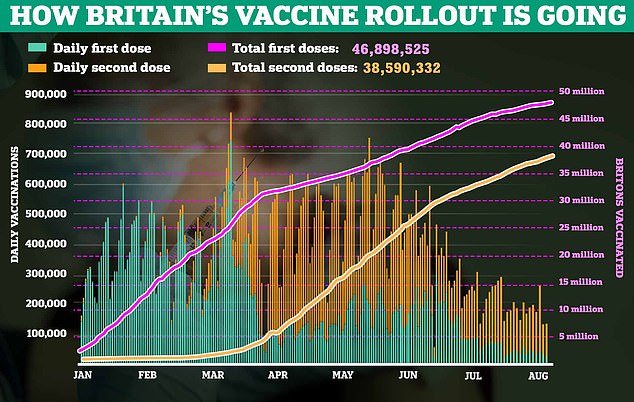
Source link : https://www.dailymail.co.uk/news/article-9856507/Covid-cases-unvaccinated-Brits-THREE-times-higher-compared-fully-immunised.html











